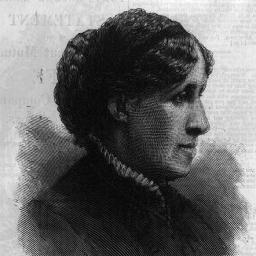Abigail Smith Adams

Hailed for her now-famous admonition that the Founding Fathers “remember the ladies” in their new laws, Abigail Adams was not only an early advocate for women’s rights, she was a vital confidant and advisor to her husband John Adams, the nation’s second president. She opposed slavery and supported women’s education.
Born to a prominent family in Weymouth, Massachusetts on November 22 [November 11, Old Style], 1744, Adams’ father, Reverend William Smith, was part of a prestigious ministerial community within the Congregational Church. Her mother Elizabeth was a descendent of the Quincy family. Like other women, Abigail had no formal education, but she availed herself of the family’s library to master subjects most women never considered. She also joined her mother in tending to the poor and sick.
In 1764, Abigail married John Adams, a Harvard graduate beginning a law career. The couple moved to Adams’ farm in Braintree, south of Boston, and had three sons and two daughters. As her husband increasingly traveled as a lawyer, political revolutionary, and—after the Revolution—a diplomat, Abigail managed their farm and business affairs while raising the children. Although married women at this time had limited property rights, Adams began to refer to their property as hers. She also made investment decisions that enhanced the family’s prosperity.
From their earliest married days, the couple began an extensive correspondence, which provides insight into the social and political climate of the Revolutionary and Early National periods in American history. In 1776, as her husband participated in the First Continental Congress in Philadelphia, Adams wrote her most famous letter that the Founding Fathers “remember the ladies.” She added, “Do not put such unlimited power into the hands of the husbands. Remember all men would be tyrants if they could.”
Though not exactly the feminist some historians have depicted her to be, Adams was concerned with greater protection for women under the new laws, as well as access to formal education. She allied with Judith Sargent Murray’s efforts to expand women’s education because Adams, too, saw mothers as having a vital role in preparing sons to be virtuous citizens and leaders in the new republic. Though John Adams did not take his wife’s letter seriously, throughout his life, he sought her opinions on political and other matters. She traveled with him throughout Europe for five years (1783-1788) during his stint as a diplomat. When he was elected president in 1797, Adams eagerly wrote to his wife, “I never wanted your Advice and assistance more in my life…” An outspoken First Lady, Adams often defended her husband’s positions, including his advocacy of the controversial Alien and Sedition Acts (1798).
In 1800, the Adams became the first First Family to occupy the White House, after the capital moved from Philadelphia to Washington, DC. When Adams lost his re-election bid in 1801, the couple retreated to Massachusetts, where Abigail maintained correspondence with political leaders including presidents Thomas Jefferson—who defeated her husband in a bitter election—and James Madison, as well as Dolley Madison, who remained influential after her husband’s death. Adams also worked for the political advancement of her son, John Quincy Adams, though she would not live to see his election as president in 1824. Her grandson, Charles Francis Adams published Adams’ letters in 1848.
- "Abigail Adams." Encyclopedia of World Biography. Vol. 18. Detroit: Gale, 1998. U.S. History in Context. Accessed February 2, 2015.
- “Abigail Adams.” Massachusetts Historical Society. Accessed February 2, 2015.
- “Abigail Adams Biography.” National Park Service. Accessed February 2, 2015.
- “American Presidents, A Reference Source: John Adams. Abigail Adams.” Accessed February 1, 2015.
- Butterfield, L.H. “Abigail Adams” in James, Edward T., Janet Wilson James, Paul S. Boyer. Notable American Women: 1607-1950, A Biographical Dictionary. Cambridge: Belknap Press, 1971.
- Roberts, Cokie. Founding Mothers: The Women Who Raised Our Nation. New York: HarperCollins Publishers Inc., 2004. p 72.
- Weatherford, Doris. American Women’s History: An A to Z of People, Organizations, Issues, and Events. New York: Macmillan General Reference, 1994.
- PHOTO: Library of Congress
MLA - Michals, Debra. “Abigail Adams.” National Women’s History Museum. National Women’s History Museum, 2015. Date accessed.
Chicago - Michals, Debra. “Abigail Adams.” National Women’s History Museum. 2015. www.womenshistory.org/education-resources/biographies/abigail-smith-adams.
Web Sites:
Books:
- Adams, Abigail. The Book of Abigail and John: Selected Letter of the Adams Family, 1762-1784. Cambridge, MA: Harvard University Press, 1975.
- Adams, Charles Francis. Familiar Letters of John Adams and His Wife Abigail Adams During the Revolution. New York: Penguin Books, 2004. (originally printed in 1875 in Boston)
- Adams, John. The Adams-Jefferson Letters: The Complete Correspondence Between Thomas Jefferson and Abigail and John Adams. Two Volumes. Chapel Hill: University of North Carolina, 1959.
- Akers, Charles W., Abigail Adams: An American Woman. Boston: Little, Brown & Company, 1980.
- Gelles, Edith B., Portia: The World of Abigail Adams. Bloomington: Indiana University Press, 1992.
- Nagel, Paul C. The Adams Women: Abigail and Louisa Adams, Their Sisters and Daughters.
- New letters of Abigail Adams, 1788-1801. Ed. Stewart Mitchell. Boston, Houghton Mifflin Co., 1947.




